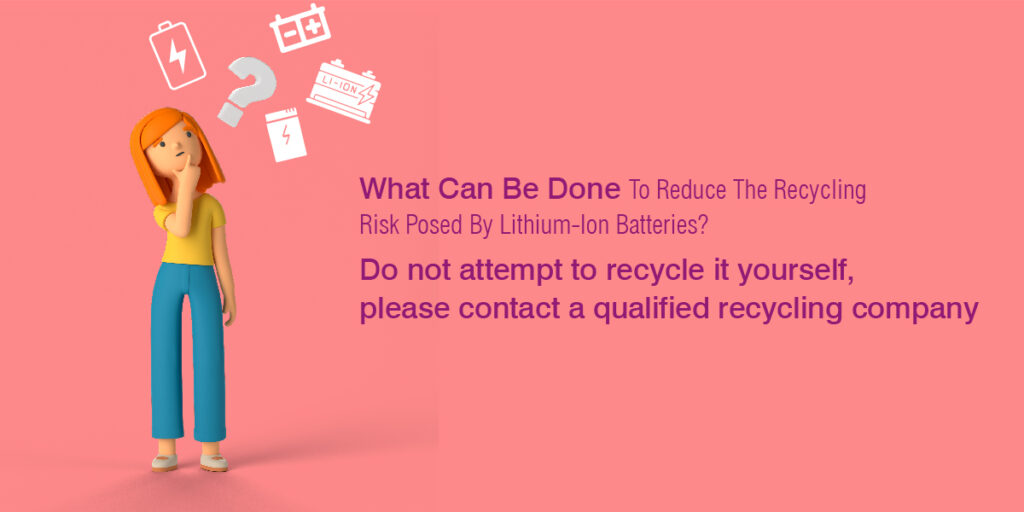Lithium-ion batteries are a type of rechargeable battery utilized in electronics and automobiles. They can be found in cordless tools, laptops, cellphones, digital cameras, electric vehicles, bicycles, and wheelchairs.
Akira Yoshino created the first prototype lithium-ion battery in the 1980s, but it didn’t become a commercial product until the 1990s. Since then, there have been worries about how to recycle them.
Lithium-ion batteries are small, powerful, and increasingly ubiquitous. But they also pose a significant recycling risk.
Why are Lithium-Ion Batteries Dangerous?
Lithium-ion batteries are dangerous because of their chemical composition. They contain a flammable electrolyte that can cause fires and explosions if damaged. And with more and more lithium-ion batteries being used in consumer electronics, the risk of accidents is growing.
The battery’s primary components are the positive electrodes (often lithium cobalt oxide, lithium iron phosphate, or lithium manganese oxide), negative electrodes (often graphite), and electrolytes. The electrolyte is a solvent containing lithium salt.
Lithium reacts with water to form lithium hydroxide and hydrogen gas in its pure state. That’s why the batteries have a hard case to keep water out. A fire or explosion may occur if the casing is damaged, which could cause a major fire in a recycling or garbage truck or factory.
Can They Be Recycled?
Yes, you can recycle lithium-ion batteries—but the process is complex and expensive. That’s because the cells contain a variety of metals and chemicals that must be separated and cleaned before you can reuse the battery.
The recycling process begins by crushing the battery into small pieces. The small pieces are then placed in a furnace, where they are heated to more than 2,000 degrees Fahrenheit. Doing so melts the metals and separates them from the plastic and other materials.
The metals are then cooled and cast into ingots. You can then use them to make new batteries or other products.
The recycling process is complex and expensive because it requires special equipment and trained personnel. And it’s not always possible to recycle all of the materials in a battery. For example, some lithium-ion batteries contain cobalt, which is a valuable metal. However, you must handle it carefully to avoid contamination.
So What Can Be Done To Reduce The Recycling Risk Posed By Lithium-Ion Batteries?
For one, manufacturers can design safer batteries. And recycling companies can invest in better facilities and processes.
 But ultimately, it’s up to consumers to dispose of their lithium-ion batteries responsibly. That means making sure they end up in the hands of qualified recyclers.
But ultimately, it’s up to consumers to dispose of their lithium-ion batteries responsibly. That means making sure they end up in the hands of qualified recyclers.Do not attempt to recycle it yourself. And never throw it in the trash! If you have a lithium-ion battery that you need to recycle, please contact a qualified recycling company.
ITAD USA for Electronics Recycling
Don’t worry about your batteries or other outdated equipment again.
ITAD USA can help!
According to all state and federal regulations, our clients’
e-waste disposal needs are met lawfully, thanks to our Availability policy. In addition, we are R2:2013 certified and regularly get third-party inspections of our facilities and downstream processors.
The following procedure is used to dispose of any computer equipment that is not able to be resold:
- R2:2013 certification
- Zero landfill policy
- Meet all local and federal regulations
- We will not export it to illicit foreign buyers.
Let us know how we can help. Contact us today for a
free project assessment at
or
fill out the online form, and we will get back to you.
 But ultimately, it’s up to consumers to dispose of their lithium-ion batteries responsibly. That means making sure they end up in the hands of qualified recyclers.Do not attempt to recycle it yourself. And never throw it in the trash! If you have a lithium-ion battery that you need to recycle, please contact a qualified recycling company.
But ultimately, it’s up to consumers to dispose of their lithium-ion batteries responsibly. That means making sure they end up in the hands of qualified recyclers.Do not attempt to recycle it yourself. And never throw it in the trash! If you have a lithium-ion battery that you need to recycle, please contact a qualified recycling company.

